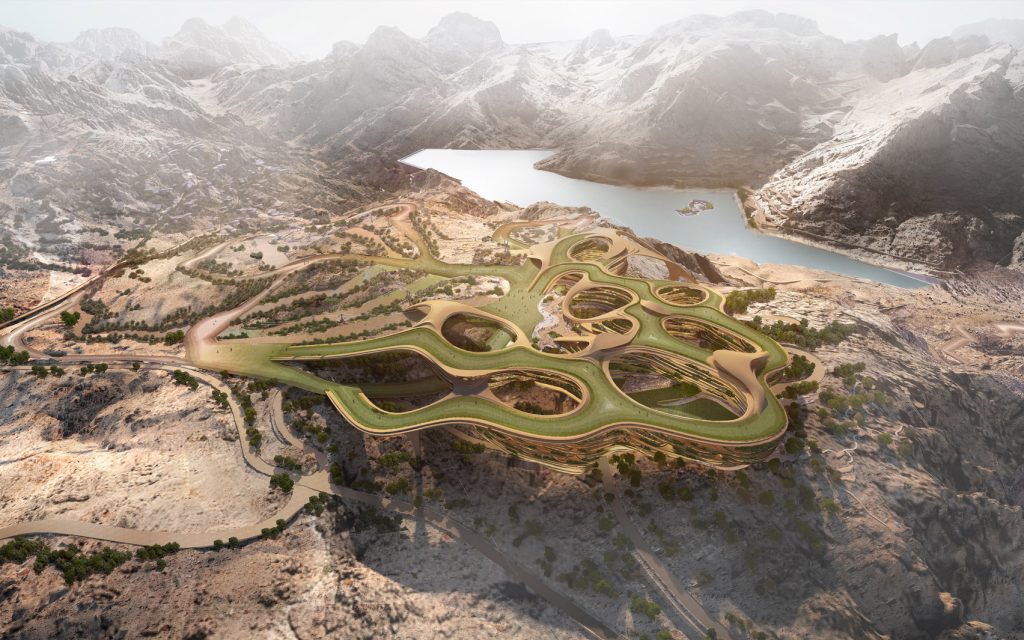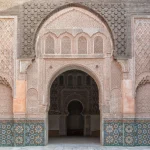The differing qualities of design in Saudi Arabia highlight the mixing of ancient traditions and modern innovations, contributing to the Kingdom’s unique architectural landscape. The architectural landscape of Saudi Arabia is a testament to the country’s vision to seamlessly merge its ancient traditions and time-honored techniques with modern innovations and a forward-looking vision. This fusion of styles creates an assorted architectural identity for the Kingdom while shaping a bold new skyline.
Saudi Arabian architecture combines traditional design elements and modern architectural features. It is a striking representation of the cultural legacy of the Kingdom and its urban development, greatly impacted by its geography and climate. Traditional Saudi architecture is constructed using locally sourced materials such as limestone, coral, and mudbrick. Additional elements like courtyards, intricate latticed windows, and thick mudbrick walls were employed to withstand the severe desert climate.
Conversely, the modern architectural landscape of Saudi Arabia redefines the skyline with its cutting-edge designs and contemporary skyscrapers, reflecting the country’s rapid urbanization and development in recent years. As a result, Saudi architecture is evolving to include sustainability and futuristic urban planning with an eye toward the future and a vision to balance cultural identity with modernity.
Traditional and Vernacular Architecture
There are Remnants of vernacular architecture all over Mecca, Medina, Jeddah, and Taif. With their linear design and rectilinear forms, Hijazi-style buildings are notorious landmarks and can be seen in Jeddah’s old market.
Nabatean Architecture: The Nabatean civilization persisted for approximately 200 years and left behind sophisticated stone monuments. In fact, their architectural style was influenced by the Mesopotamians and Greeks, and they carved the entrances of temples and tombs out of rock cliffs. Perhaps the best illustration of this ancient style is the rock-cut tombs of Al-Hijr (Madâin Sâlih), comparable to those in Petra, Jordan.
Mudbrick Architecture: Found in regions like Najran and the historic Diriyah, this style is famous for its desert-adaptive urban and architectural patterns. For instance, Najdi architecture uses clay, mudbrick, and adobe construction, characterized by thick walls and small windows, to isolate interior spaces from extreme heat.
Coral Stone Architecture: This style is often encountered in coastal cities such as Jeddah, where coral stones are used to build houses, often featuring wooden latticework known as “Mashrabiya.”
Asir Region Architecture: This high-mountain province is known for its colorful, geometric-painted houses, which reflect the local culture and artistic traditions.
Traditional Saudi Architecture
The hot and arid climate of Saudi Arabia notably impacts the country’s architectural design. For instance, the use of thick walls and small windows helps keep out the heat. Buildings incorporate other features, such as wind towers and courtyards, to enhance natural ventilation. In fact, traditional Saudi architecture is a vivid reflection of the region’s culture and harsh climate, exhibiting a profound association between the built environment and its natural surroundings.
Moreover, buildings are designed with local materials like mudbrick and stone, offering insulation from the extreme heat, while intricate lattice windows, known as “Mashrabiya,” permit airflow and privacy—both crucial elements in the social customs. Furthermore, the inward-focused design of homes, with central courtyards, provides privacy and shade, key aspects of the nation’s social and cultural life. The courtyards serve as communal spaces designed to foster community interaction and promote family gatherings and social cohesion. The architecture’s versatility and adaptability to the environment, combined with its embodiment of social and cultural values, make it a living confirmation of the resourcefulness and traditions of the Saudi people.
Historic mosques are a great illustration of how the architectural style of Saudi Arabia mirrors the region’s culture and climate. They have been continuously developing to meet people’s needs throughout the four seasons of the year. In Najd, Al Ahsaa, and the North of the Kingdom, the prayer hall is regularly opened to the courtyard from noon to afternoon in the summertime. Also, most Najdi mosques are equipped with staircases to enable people to perform their sunset, evening, and dawn prayers on the rooftop. In winter, underground hermitages connected to the hall by a staircase were either used for night prayers or all prayers, depending on the weather conditions.
Islamic Architecture
Architecture influenced by Islamic tradition is distinguished by its intricate patterns, geometric shapes, and use of calligraphy. Mud, clay, stone, and other traditional materials are commonly used in construction.
Mosques: In Saudi Arabia, historic mosques have continuously been interlaced with neighboring blocks, and many used minarets as landmarks within their urban setting. Some of the most noticeable mosques in the Islamic world are located in the Kingdom, namely the Grand Mosque in Mecca (Masjid al-Haram) and the Prophet’s Mosque in Medina (Al-Masjid an-Nabawi). Grand scale, minarets, domes, and intricate geometric and calligraphic designs define and embellish these structures.
In most cases, historical mosques are generally not ornamented. Some architectural designs, however, incorporate frescoes and engraved wooden doors, considered functional adornments. In fact, many of Saudi Arabia’s universities, museums, and government buildings incorporate elements of Islamic architecture, including arches, domes, and courtyards, but with a modern twist.
Modern Architecture
Saudi Arabia’s modern architecture is a striking reflection of the Kingdom’s rapid transformation and driven vision for the future. Iconic structures with contemporary, sleek designs and subtle nods to Islamic geometry and cultural heritage dominate the skyline. For instance, Al Faisaliah Tower, the Kingdom Centre, and the Jeddah Tower (under construction, set to be the world’s tallest upon completion) showcase this ambitious and forward-thinking approach, positioning Saudi Arabia as a key player within the global architectural scene.
Mega Projects of Saudi Arabia
Driven by the Vision 2030 initiative and with an eye on the future, Saudi Arabia is undergoing an unprecedented transformation with several mega projects reshaping its architectural and urban landscape. These ambitious projects will attract huge crowds, making the Kingdom a must-visit destination for every traveler.
NEOM
NEOM is made up of the prefix ‘neo’—which means new—and the letter ‘m,’ the first letter of the Arabic word for future, Mustaqbal. It is a $500 billion futuristic city being built on the west coast, across the Red Sea from Sharm El-Sheikh, and will consist of renewable energy, cutting-edge technology, and sustainable living. The Line, a 170-kilometer-long linear city, is one of its major components, designed to showcase a bold vision for urban living with zero cars and zero emissions.
Red Sea Project
The Red Sea is a luxury tourism initiative grounded in sustainability and sustainable high-end tourism in its fullest sense. It is a destination where sustainability, luxury, and innovation intersect to redefine the way development is done. It features pristine beaches, eco-friendly resorts, and conservation strategies to protect the local ecosystem.
Qiddiya
Qiddiya is an entertainment city near Riyadh and will be Saudi Arabia’s finest entertainment, sports, and cultural destination that concretizes the Saudi identity. The project intends to attract both local and international tourists and be home to more than 600,000 residents. Every year, the city will host millions of visitors and experience seekers. Additionally, its impressive natural landscapes will eventually become its most distinctive hallmark.
King Salman Park
In an effort to make Riyadh an internationally attractive city, King Salman Park is one of many innovative, multibillion-dollar projects initiated by the Saudi government. It is set to be the world’s largest park and green district, covering 13.3 square kilometers on the grounds of the city’s old airport. The project calls for new mixed-use developments aimed at blending green spaces with cultural and recreational facilities, including museums, art galleries, and theaters.
Diriyah Gate
Diriyah is the birthplace of the Saudi kingdom. First and foremost, it is a location that is very significant to the Saudi royal family and the national identity. With the settlement of Imam Muhammad in 1744 and the valiant military defense of the city against subsequent invasions, “Arabia” initially became “Saudi” at this location. A UNESCO World Heritage site lies at the center of the new cultural and lifestyle tourism destination, Diriyah Gate.
One of the kingdom’s cultural and leisure hubs, the seven-square-kilometer mega project will offer areas for people to explore, gather, dine, shop, live, and work. Inspired by the kingdom’s historical, artistic, and cultural legacy, the attraction will appeal to both foreign tourists and locals seeking genuine cultural experiences. The Diriyah Gate reflects a vision and dedication to presenting more than 300 years of Saudi Arabia’s history to the world in many facets of history, hospitality, education, shopping, and dining experiences.































Leave a comment